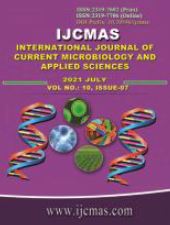


 National Academy of Agricultural Sciences (NAAS)
National Academy of Agricultural Sciences (NAAS)

|
PRINT ISSN : 2319-7692
Online ISSN : 2319-7706 Issues : 12 per year Publisher : Excellent Publishers Email : editorijcmas@gmail.com / submit@ijcmas.com Editor-in-chief: Dr.M.Prakash Index Copernicus ICV 2018: 95.39 NAAS RATING 2020: 5.38 |
Pomegranate (Punica granatum L.) of Lythraceae family, called “fruit of paradise” is one of the major fruit crops of arid region. At present, the known fungal disease agents of pomegranate are Colletotrichum gloeosporioides, Alternaria spp., Botrytis cinerea, Aspergillus niger, Pestalotiopsis versicolor, Penicillium spp. and Rhizopus spp. Among the various fungal diseases, anthracnose caused by Colletotrichum gloeosporioides is the most important post harvest diseases in pomegranate. In this study, several fungicides and bio agents were evaluated against this pathogen. Among systemic fungicides, propiconazole 25% EC, hexaconazole 5% EC, iprobenfos 48% EC and kresoxim methyl 44.3% EC recorded cent per cent mycelial inhibition of Colletotrichum gloeosporioides. Among six contact and seven combi products (1000, 1500, 2000 and 3000 ppm), mancozeb 75% WP, zineb 75% WP, tricyclazole 18 % + mancozeb 62 %, carbendazim 12% + mancozeb 63% and carboxin 37.5% + thiram 37.5% completely inhibited the growth of Colletotrichum gloeosporioide. Among different bio agents tested, Trichoderma harzianum, UAS, Dharwad isolate recorded significantly higher per cent mean inhibition followed by Trichoderma harzianum, UHS, Bagalkot isolate. Fungicides and bio agents found effective were tested in field condition for the management of pomegranate leaf spot and fruit rot. The results showed that mancozeb 75% WP, carbendazim 12% + mancozeb 63% and propiconazole 25% EC @ 0.1% were effective in controlling the leaf spot and fruit rot incidence as compared to other treatments.
 |
 |
 |
 |
 |